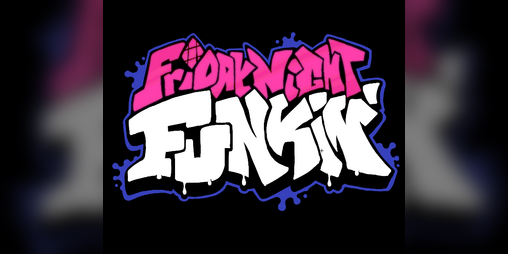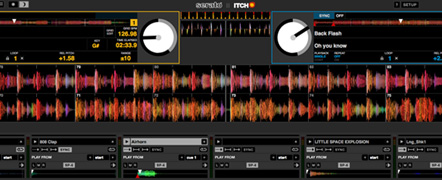'This, dear reader, is about as far away from 'toy' as a controller gets ... the NS6 is a beast.'
- DJWorx.com
ITCH is a high-performance portable music system with internal mixing and platter-style playback control. Because it is designed specifically for use with hardware control, ITCH has a clean information display.
- Luminosity masks allow you to create gorgeous and realistic edits in Photoshop. Lumenzia allows you to use use them quickly and easily. Its advanced javascript engine handles all the luminosity masking complexity for you in the background, so all you need to think about is making beautiful images.
- 'A clever little game, with stylish retro pixel art animation and a thought-provoking narrative.' (Free Game Planet)'Luminous is the sort of high-minded but unpolished game that made me fall in love with the indie community.'
- Roblox Noob OS V. Based on a video 'Roblox Noob OS'. (In MAC OS not everything works well).
Rock-solid and portable, analog and digital, practical and powerful. With NS6, groundbreaking technology blends with Numark's decades of expertise in engineering cutting-edge DJ gear to gives you one of the world's most advanced controllers. Designed in partnership with Serato, NS6 delivers incredible 4-deck performance with the groundbreaking capabilities of Serato DJ software. NS6 comes ready to control four channels of software plus external sources. Connect and mix CD players, turntables, MP3 players, and more right along side Serato DJ. NS6 is ready to go wherever you want to take it — both physically and musically.
High-Resolution Control
NS6’s aluminum platters are supported by the same ultra-high-resolution MIDI as the award-winning NS7 and the all-new NS7II—3600 ticks of resolution per rotation. It’s the tightest response ever produced in a DJ controller. When combined with NS6’s automatically adjusted platter sensitivity the result is ultra-precise, high definition turntable control. Beyond the platters, NS6 keeps your mix super tight with high-resolution 14-bit MIDI control throughout. Designed to work flawlessly with Serato DJ, NS6 erases the line between hardware and software. Bi-color LEDs also surround each platter, providing both an indication of the deck in control and also a Deck’s playback status, and effects can be instantly accessed by channel.
“Well built, nicely laid out, gorgeous jogwheel performance, true pro feature set, great sound quality, lots of flexibility ... a stylish, fun and professional DJing solution right from the box.” -Digital DJ Tips
Independent Mixer
At the heart of NS6 is a four-channel mixer that can operate standalone, which means you can mix up to four external sources without even turning your computer on. Connect and mix CD players, turntables, MP3 players, or any other external source—you never have to worry about the awkward silence and inevitable moans of an unhappy crowd. Plus, the built-in 24-bit audio interface was engineered without compromise, giving NS6 audiophile-grade circuitry that keeps your mix clean and clear.
Connect Anything
A full range of input and outputs for connecting virtually any device: RCA inputs on each channel and four line-level inputs with two switchable to phono and two switchable to mic. Each of NS6’s four channels has an input selector so you can easily transition between controlling Serato DJ’s four software decks and your external sources. Control Serato one moment; mix in your turntable, iPod, or a mic the next. NS6 makes it possible to grab music from virtually any source and bring it into your mix.
Enhanced Strip Search
Using just the tip of your finger, you can glide to any point in a track effortlessly, then drop the virtual needle exactly where you want to be. Initially introduced on NS7, Numark’s exclusive Strip Search virtual-needle-drop technology now includes a parallel string of bright red LEDs, so you can tell where the track is just by looking. It’s one less reason to be staring at your computer screen. NS6’s combination of premium features don’t require you to conform to them. They conform to you, empowering you to perform and mix at your highest level. In addition, unlike some imitations, the Strip Search touch strips are positioned intuitively, so you will never hit them accidentally.
“ ... the perfect balance of “serious” size with DJ-friendly portability.” - DJ Tech Tools
The precise steps you need to follow to install the panel will depend on the version of Photoshop you are using.
So before moving on to the installation steps, first open Photoshop and look at the version number at the very top of the application:
For Photoshop CC users, the version will usually be shown like in the screenshot above.
If you do not see a version number at the top like in the screenshot above, then choose “Window > Application Frame” from the menu to see if that makes it appear.
Lumosity Itch Mac Os Pro

If you can see the Application Frame but it doesn’t contain a version number, then browse to the “About Photoshop” menu item (which can be found under the “Photoshop” menu on a Mac, or under the “File” menu on a PC).
This will bring up an “about” box that should indicate the version number:
Photoshop CC Installation
- Download the appropriate installation file for your Photoshop CC from the members area (click here to log in and download)
- Once downloaded, double-click the zip file to extract it’s contents.
- This will result in a folder being created with the name: com.luminositymaskingpanel.ppmpanel
- Copy the entire com.luminositymaskingpanel.ppmpanel folder into the correct folder for your Creative Cloud version. You have to create the folder if it does not exist.
- If you have Photoshop CC 2014, CC 2015, CC 2015.5, CC 2017 or above:
- Mac OS:
/Library/Application Support/Adobe/CEP/extensions/ - Windows x64:
C:/Program Files (x86)/Common Files/Adobe/CEP/extensions/ - Windows x32:
C:/Program Files/Common Files/Adobe/CEP/extensions/
- Mac OS:
- If you have Photoshop CC (old version):
- Mac OS:
/Library/Application Support/Adobe/CEPServiceManager4/extensions/ - Windows x64:
C:/Program Files (x86)/Common Files/Adobe/CEPServiceManager4/extensions/ - Windows x32:
C:/Program Files/Common Files/Adobe/CEPServiceManager4/extensions/
- Mac OS:
- If you have Photoshop CC 2014, CC 2015, CC 2015.5, CC 2017 or above:
- Restart Photoshop. You will find the extension at Window > Extensions >PPM Luminosity Masking Panel V1_0
Photoshop CS5 / CS6 Installation
- Download the appropriate installation file for your Photoshop CS5 / CS6 from the members area (click here to log in and download)
- Once downloaded, double-click the zip file to extract it’s contents.
- This will result in a folder being created with the name: PPM Panel v CS 1_0
- Copy the entire PPM Panel v CS 1_0 folder into the correct folder for your CS version of Photoshop. You have to create the folder if it does not exist.
- If you have Photoshop CS5
- Mac OS:
/Applications/Adobe Photoshop CS5/Plug-ins/Panels/ - Windows x64:
C:/Program Files (x86)/Adobe/Adobe Photoshop CS5/Plug-ins/Panels/ - Windows x32:
C:/Program Files/Adobe/Adobe Photoshop CS5/Plug-ins/Panels/
- Mac OS:
- If you have Photoshop CS6
- Mac OS:
/Applications/Adobe Photoshop CS6/Plug-ins/Panels/ - Windows x64:
C:/Program Files (x86)/Adobe/Adobe Photoshop CS6/Plug-ins/Panels/ - Windows x32:
C:/Program Files/Adobe/Adobe Photoshop CS6/Plug-ins/Panels/
- Mac OS:
- If you have Photoshop CS5
- Restart Photoshop. You will find the extension at Window > Extensions > PPM Panel V CS 1_0
Troubleshooting

Here I will add the solutions to common installation issues that are reported to me. If you are experiencing issues installing the Panel, please check every one of these possible causes. If none of them solve the issue for you, please provide details via the feedback form here.
Issue: I can’t find the Panel in Photoshop
A1: Thing to check (ALL USERS): If you have installed the panel but it is not appearing in Photoshop, then the first thing to check is whether you have “opened” it via the “Window > Extensions” menu. If not, then restart the Photoshop application, then see the screenshot below for where to find the Panel.
If the panel is not listed in the Extensions menu, then the most likely reason is that the panel folder has not been copied into the correct folder on your computer (as per step 4 in the instructions).
A2: Thing to check (Mac users with Photoshop CC): By far the most common reason among Mac users is the confusion caused by the fact there are two almost identical file/folder paths that look like the correct one – but only one of them is the correct one. Watch this video for the full explanation:
A3: Thing to Check (ALL USERS): If you are 100% certain you’ve copied the panel folder into the correct location but it is still not appearing in the Extensions menu in Photoshop, next, verify the panel folder extracted correctly.
For some reason, when some users double-click to extract the downloaded zip file, an extra level of folders gets created. For example, the com.luminositymaskingpanel.ppmpanel folder gets created with another com.luminositymaskingpanel.ppmpanel folder inside it…
To eliminate this as the issue, check to see if the folder you have installed has another folder inside it with the same name. If it does, delete the top level folder then repeat installation step 4 but copy the inner com.luminositymaskingpanel.ppmpanel folder into the extensions folder.
A4: Thing to Check (WINDOWS USERS): x86 Folder issues
You might find you have BOTH the following folders on your computer:
- C:/Program Files (x86)
- C:/Program Files <–without the (x86)
If you do have both, and you’ve installed the panel folder in the adobe extensions folder in one of them and it’s not appearing in Photoshop, then try the other equivalent folder.
For example if the instructions above tell you to install the panel here:
- C:/Program Files (x86)/Common Files/Adobe/CEP/extensions/
And it’s not working, try installing the panel here:
Lumosity Itch Mac Os Catalina
- C:/Program Files/Common Files/Adobe/CEP/extensions/
Luminosity (itch) Mac Os Download
A5: Thing to Check: Non-English versions of Windows/Mac
Mac Os Mojave
If you have your computer configured in a language other than English, then you may have a “Program Files” (windows) or “Applications” (mac) folder available, as well as the equivalent in your language. The only example I’ve seen of this is a French-Canadian customer who had to install the panel in their “Fichiers de programme” folder, which I think means Program Files. But I assume the same applies to other languages too.
Issue: I’m getting an error when I try to open the Panel
B1: Thing To Check (ALL USERS): The first thing to check is that you have downloaded and installed the correct version of the panel according to the version of Photoshop you are using.
There are now three available downloads, one for each Photoshop version CS5, CS6 and CC.
If you are receiving an error message when opening the panel, then most likely you have installed the wrong version.